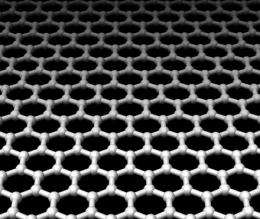New wonder material, one-atom thick, has scientists abuzz

Imagine a carbon sheet that's only one atom thick but is stronger than diamond and conducts electricity 100 times faster than the silicon in computer chips. That's graphene, the latest wonder material coming out of science laboratories around the world. It's creating tremendous buzz among physicists, chemists and electronic engineers.
"It is the thinnest known material in the universe, and the strongest ever measured," Andre Geim, a physicist at the University of Manchester, England, wrote in the June 19 issue of the journal Science.
"A few grams could cover a football field," said Rod Ruoff, a graphene researcher at the University of Texas, Austin, in an e-mail. A gram is about 1/30th of an ounce.
Like diamond, graphene is pure carbon. It forms a six-sided mesh of atoms that, through an electron microscope, looks like a honeycomb or piece of chicken wire. Despite its strength, it's as flexible as plastic wrap and can be bent, folded or rolled up like a scroll.
Graphite, the lead in a pencil, is made of stacks of graphene layers. Although each individual layer is tough, the bonds between them are weak, so they slip off easily and leave a dark mark when you write.
Potential graphene applications include touch screens, solar cells, energy storage devices, cell phones and, eventually, high-speed computer chips.
Replacing silicon, the basic electronic material in computer chips, however, "is a long way off ... far beyond the horizon," said Geim, who first discovered how to produce graphene five years ago.
"In the near- and medium-term, it's going to be extremely difficult for graphene to displace silicon as the main material in computer electronics," said Tomas Palacios, a graphene researcher at the Massachusetts Institute of Technology. "Silicon is a multibillion-dollar industry that has been perfecting silicon processing for 40 years."
Government and university laboratories, long-established companies such as IBM, and small start-ups are working to solve difficult problems in making graphene and turning it into useful products.
Ruoff founded a company in Austin called Graphene Energy, which is seeking ways to store renewable energy from solar cells or the energy captured from braking in autos.
The Pentagon is also interested in this new high-tech material. The Defense Advanced Research Projects Agency is spending $22 million on research to make computer chips and transistors out of graphene.
Graphene was the leading topic at the annual meeting of the American Physical Society _ a leading organization of physicists _ in Pittsburgh in April. Researchers packed 23 panel sessions on the topic. About 1,500 scientific papers on graphene were published in 2008 alone.
Until last year, the only way to make graphene was to mount flakes of graphite on sticky tape and separate a single layer by carefully peeling away the tape. They called it the "Scotch Tape technique."
Recently, however, scientists have discovered a more efficient way to produce graphene on an underlying base of copper, nickel or silicon, which subsequently is etched away.
"There has been spectacular progress in the last two or three months," Geim reported in the journal Science. "Challenges that looked so daunting just two years ago have suddenly shrunk, if not evaporated."
"I'm confident there will be many commercial applications," Ruoff said. "We will begin to see hybrid devices -- mostly made from silicon, but with a critical part of the device being graphene -- in niche applications."
___
ON THE WEB
More from the University of Texas, Austin: www.engr.utexas.edu/news/artic … 0905071710/index.cfm
More from MIT: web.mit.edu/newsoffice/2009/gr … e-palacios-0319.html
• Join PhysOrg.com on Facebook!
• Follow PhysOrg.com on Twitter!
(c) 2009, McClatchy-Tribune Information Services.
Visit the McClatchy Washington Bureau on the World Wide Web at www.mcclatchydc.com
















